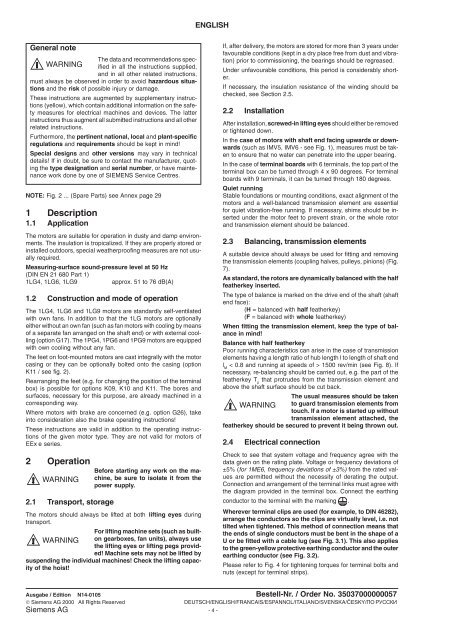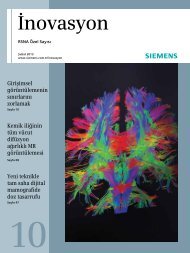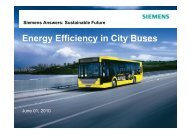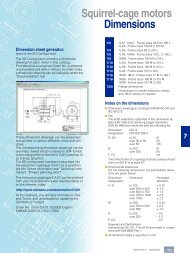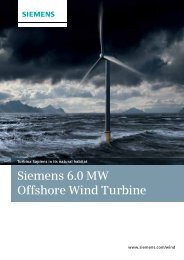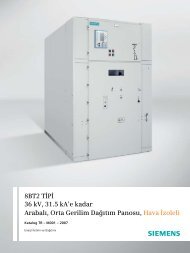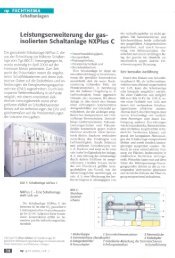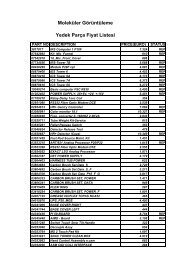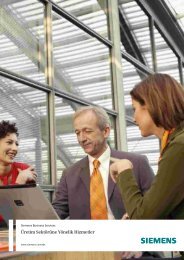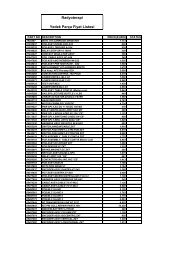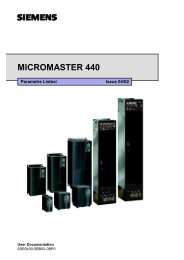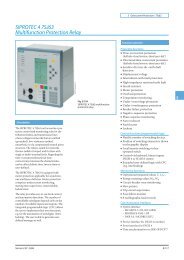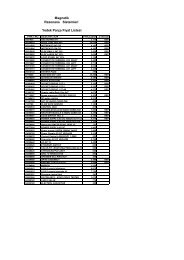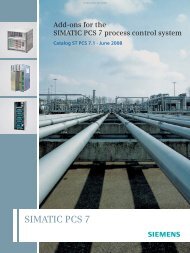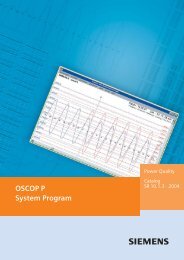Drehstrommotoren 1LG4 1LG6 1LG9 - Siemens
Drehstrommotoren 1LG4 1LG6 1LG9 - Siemens
Drehstrommotoren 1LG4 1LG6 1LG9 - Siemens
Create successful ePaper yourself
Turn your PDF publications into a flip-book with our unique Google optimized e-Paper software.
ENGLISH<br />
General note<br />
The data and recommendations specified<br />
in all the instructions supplied,<br />
WARNING<br />
and in all other related instructions,<br />
must always be observed in order to avoid hazardous situations<br />
and the risk of possible injury or damage.<br />
These instructions are augmented by supplementary instructions<br />
(yellow), which contain additional information on the safety<br />
measures for electrical machines and devices. The latter<br />
instructions thus augment all submitted instructions and all other<br />
related instructions.<br />
Furthermore, the pertinent national, local and plant-specific<br />
regulations and requirements should be kept in mind!<br />
Special designs and other versions may vary in technical<br />
details! If in doubt, be sure to contact the manufacturer, quoting<br />
the type designation and serial number, or have maintenance<br />
work done by one of SIEMENS Service Centres.<br />
NOTE: Fig. 2 ... (Spare Parts) see Annex page 29<br />
1 Description<br />
1.1 Application<br />
The motors are suitable for operation in dusty and damp environments.<br />
The insulation is tropicalized. If they are properly stored or<br />
installed outdoors, special weatherproofing measures are not usually<br />
required.<br />
Measuring-surface sound-pressure level at 50 Hz<br />
(DIN EN 21 680 Part 1)<br />
<strong>1LG4</strong>, <strong>1LG6</strong>, <strong>1LG9</strong><br />
approx. 51 to 76 dB(A)<br />
1.2 Construction and mode of operation<br />
The <strong>1LG4</strong>, <strong>1LG6</strong> and <strong>1LG9</strong> motors are standardly self-ventilated<br />
with own fans. In addition to that the 1LG motors are optionally<br />
either without an own fan (such as fan motors with cooling by means<br />
of a separate fan arranged on the shaft end) or with external coolling<br />
(option G17). The 1PG4, 1PG6 and 1PG9 motors are equipped<br />
with own cooling without any fan.<br />
The feet on foot-mounted motors are cast integrally with the motor<br />
casing or they can be optionally bolted onto the casing (option<br />
K11 / see fig. 2).<br />
Rearranging the feet (e.g. for changing the position of the terminal<br />
box) is possible for options K09, K10 and K11. The bores and<br />
surfaces, necessary for this purpose, are already machined in a<br />
corresponding way.<br />
Where motors with brake are concerned (e.g. option G26), take<br />
into consideration also the brake operating instructions!<br />
These instructions are valid in addition to the operating instructions<br />
of the given motor type. They are not valid for motors of<br />
EEx e series.<br />
2 Operation<br />
WARNING<br />
2.1 Transport, storage<br />
Before starting any work on the machine,<br />
be sure to isolate it from the<br />
power supply.<br />
The motors should always be lifted at both lifting eyes during<br />
transport.<br />
For lifting machine sets (such as builton<br />
gearboxes, fan units), always use<br />
WARNING<br />
the lifting eyes or lifting pegs provided!<br />
Machine sets may not be lifted by<br />
suspending the individual machines! Check the lifting capacity<br />
of the hoist!<br />
If, after delivery, the motors are stored for more than 3 years under<br />
favourable conditions (kept in a dry place free from dust and vibration)<br />
prior to commissioning, the bearings should be regreased.<br />
Under unfavourable conditions, this period is considerably shorter.<br />
If necessary, the insulation resistance of the winding should be<br />
checked, see Section 2.5.<br />
2.2 Installation<br />
After installation, screwed-in lifting eyes should either be removed<br />
or tightened down.<br />
In the case of motors with shaft end facing upwards or downwards<br />
(such as IMV5, IMV6 - see Fig. 1), measures must be taken<br />
to ensure that no water can penetrate into the upper bearing.<br />
In the case of terminal boards with 6 terminals, the top part of the<br />
terminal box can be turned through 4 x 90 degrees. For terminal<br />
boards with 9 terminals, it can be turned through 180 degrees.<br />
Quiet running<br />
Stable foundations or mounting conditions, exact alignment of the<br />
motors and a well-balanced transmission element are essential<br />
for quiet vibration-free running. If necessary, shims should be inserted<br />
under the motor feet to prevent strain, or the whole rotor<br />
and transmission element should be balanced.<br />
2.3 Balancing, transmission elements<br />
A suitable device should always be used for fitting and removing<br />
the transmission elements (coupling halves, pulleys, pinions) (Fig.<br />
7).<br />
As standard, the rotors are dynamically balanced with the half<br />
featherkey inserted.<br />
The type of balance is marked on the drive end of the shaft (shaft<br />
end face):<br />
(H = balanced with half featherkey)<br />
(F = balanced with whole featherkey)<br />
When fitting the transmission element, keep the type of balance<br />
in mind!<br />
Balance with half featherkey<br />
Poor running characteristics can arise in the case of transmission<br />
elements having a length ratio of hub length l to length of shaft end<br />
l M<br />
< 0.8 and running at speeds of > 1500 rev/min (see Fig. 8). If<br />
necessary, re-balancing should be carried out, e.g. the part of the<br />
featherkey T p<br />
that protrudes from the transmission element and<br />
above the shaft surface should be cut back.<br />
The usual measures should be taken<br />
WARNING to guard transmission elements from<br />
touch. If a motor is started up without<br />
transmission element attached, the<br />
featherkey should be secured to prevent it being thrown out.<br />
2.4 Electrical connection<br />
Check to see that system voltage and frequency agree with the<br />
data given on the rating plate. Voltage or frequency deviations of<br />
±5% (for 1ME6, frequency deviations of ±3%) from the rated values<br />
are permitted without the necessity of derating the output.<br />
Connection and arrangement of the terminal links must agree with<br />
the diagram provided in the terminal box. Connect the earthing<br />
conductor to the terminal with the marking .<br />
Wherever terminal clips are used (for example, to DIN 46282),<br />
arrange the conductors so the clips are virtually level, i.e. not<br />
tilted when tightened. This method of connection means that<br />
the ends of single conductors must be bent in the shape of a<br />
U or be fitted with a cable lug (see Fig. 3.1). This also applies<br />
to the green-yellow protective earthing conductor and the outer<br />
earthing conductor (see Fig. 3.2).<br />
Please refer to Fig. 4 for tightening torques for terminal bolts and<br />
nuts (except for terminal strips).<br />
Ausgabe / Edition N14-0105 Bestell-Nr. / Order No. 35037000000057<br />
© <strong>Siemens</strong> AG 2000 All Rights Reserved DEUTSCH/ENGLISH/FRANCAIS/ESPANNOL/ITALIANO/SVENSKA/ÈESKY/ÏÎ ÐÓÑÑÊÈ<br />
<strong>Siemens</strong> AG - 4 -


